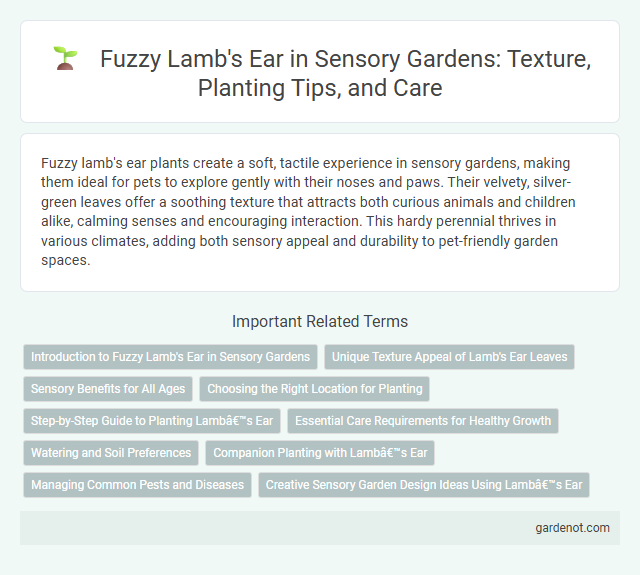Fuzzy lamb's ear plants create a soft, tactile experience in sensory gardens, making them ideal for pets to explore gently with their noses and paws. Their velvety, silver-green leaves offer a soothing texture that attracts both curious animals and children alike, calming senses and encouraging interaction. This hardy perennial thrives in various climates, adding both sensory appeal and durability to pet-friendly garden spaces.
Introduction to Fuzzy Lamb's Ear in Sensory Gardens
Fuzzy Lamb's Ear (Stachys byzantina) is a popular plant in sensory gardens due to its soft, velvety leaves that provide a unique tactile experience. Its silvery-gray foliage adds visual interest while inviting touch, enhancing sensory engagement for visitors of all ages. Highly drought-tolerant and low-maintenance, Fuzzy Lamb's Ear thrives in sunny spots, making it an ideal addition to interactive garden spaces focused on sensory stimulation.
Unique Texture Appeal of Lamb's Ear Leaves
Lamb's ear leaves feature a unique texture characterized by their soft, velvety surface that invites tactile exploration, making them ideal for sensory gardens. The densely hairy, silver-green foliage provides a comforting and distinctive touch experience that engages visitors of all ages. This tactile quality not only enhances sensory interaction but also offers a visually appealing contrast to other garden plants.
Sensory Benefits for All Ages
Fuzzy lamb's ear (Stachys byzantina) offers unique sensory benefits by stimulating touch with its soft, velvety leaves that appeal to children, adults, and seniors alike. Its tactile texture encourages exploration and sensory engagement, supporting sensory development and relaxation across all age groups. This plant enhances garden accessibility by providing a soothing, interactive experience that promotes mindfulness and sensory therapy.
Choosing the Right Location for Planting
Fuzzy lamb's ear thrives in well-drained soil with full sun to partial shade, making location selection crucial for optimal growth. Planting in areas with good air circulation helps prevent fungal diseases that can affect the soft, woolly leaves. This sensory garden favorite performs best in spots where it can receive at least six hours of sunlight daily while avoiding overly wet conditions.
Step-by-Step Guide to Planting Lamb’s Ear
Plant fuzzy lamb's ear (Stachys byzantina) in well-drained soil with full sun to partial shade for optimal growth. Space plants 12 to 18 inches apart to allow adequate air circulation and prevent fungal diseases. Water regularly but avoid overwatering to maintain the plant's soft, woolly leaves that enhance sensory garden experiences.
Essential Care Requirements for Healthy Growth
Fuzzy lamb's ear thrives in well-drained soil with full sun to partial shade, requiring moderate watering to prevent root rot while maintaining moist conditions. Regular removal of dead or damaged leaves promotes airflow and reduces the risk of fungal diseases. Fertilize lightly in spring with a balanced, slow-release fertilizer to support vigorous, healthy foliage growth essential for sensory garden appeal.
Watering and Soil Preferences
Fuzzy lamb's ear (Stachys byzantina) thrives in well-drained, sandy or loamy soil with moderate fertility, preferring a neutral to slightly alkaline pH level between 6.0 and 7.5. This drought-tolerant plant requires minimal watering, benefiting from deep, infrequent irrigation to prevent root rot and maintain its soft, velvety leaves. Overwatering can lead to fungal diseases, so allowing the soil to dry out between waterings supports optimal growth and sensory appeal in a sensory garden.
Companion Planting with Lamb’s Ear
Fuzzy Lamb's Ear (Stachys byzantina) thrives alongside plants like lavender, roses, and catmint, enhancing sensory garden diversity through its soft, velvety foliage. Its silvery leaves provide a tactile contrast while deterring pests, making it an ideal companion for aromatic and flowering plants. This synergy supports a vibrant ecosystem, promoting healthy growth and multi-sensory appeal in sensory gardens.
Managing Common Pests and Diseases
Fuzzy lamb's ear (Stachys byzantina) is susceptible to common pests such as aphids, spider mites, and slugs, which can be controlled through regular inspection and organic insecticidal treatments like neem oil. Powdery mildew and root rot are typical fungal diseases that affect fuzzy lamb's ear, preventable by ensuring proper air circulation and well-drained soil conditions. Implementing integrated pest management strategies and maintaining garden hygiene effectively minimizes damage, promoting healthy growth in sensory garden settings.
Creative Sensory Garden Design Ideas Using Lamb’s Ear
Fuzzy Lamb's Ear (Stachys byzantina) offers a tactile experience with its velvety, silvery-green leaves that invite touch and exploration in sensory gardens. Its soft texture and unique appearance make it an ideal plant to incorporate in creative sensory garden designs, enhancing both visual interest and sensory engagement. Strategic placement along pathways or near seating areas encourages interaction, providing calming and therapeutic benefits for visitors of all ages.
Fuzzy lamb’s ear Infographic

 gardenot.com
gardenot.com